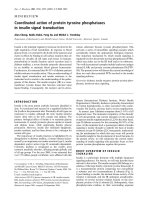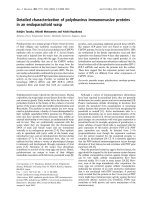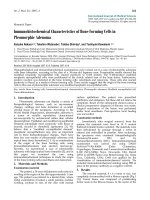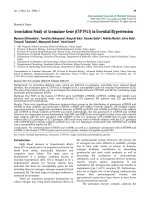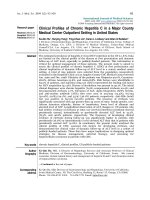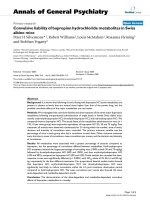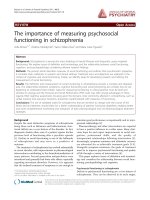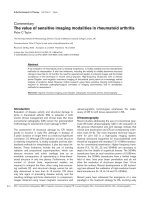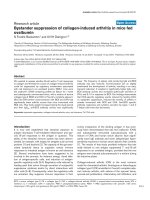Báo cáo y học: " Unusual cause of exercise-induced ventricular fibrillation in a well-trained adult endurance athlete: a case repor" docx
Bạn đang xem bản rút gọn của tài liệu. Xem và tải ngay bản đầy đủ của tài liệu tại đây (803.68 KB, 5 trang )
BioMed Central
Page 1 of 5
(page number not for citation purposes)
Journal of Medical Case Reports
Open Access
Case report
Unusual cause of exercise-induced ventricular fibrillation in a
well-trained adult endurance athlete: a case report
Stefan Vogt*
1
, Daniel Koenig
1
, Stephan Prettin
1
, Torben Pottgiesser
1
,
Juergen Allgeier
2
, Hans-Hermann Dickhuth
1
and Anja Hirschmueller
1
Address:
1
University of Freiburg, Department of Preventive and Rehabilitative Sports Medicine, Germany and
2
Interventional Cardiology, Herz-
Zentrum, Bad Krozingen, Germany
Email: Stefan Vogt* - ; Daniel Koenig - ;
Stephan Prettin - ; Torben Pottgiesser - ;
Juergen Allgeier - ; Hans-Hermann Dickhuth - ;
Anja Hirschmueller -
* Corresponding author
Abstract
Introduction: The diseases responsible for sudden deaths in athletes differ considerably with
regard to age. In young athletes, congenital malformations of the heart and/or vascular system cause
the majority of deaths and can only be detected noninvasively by complex diagnostics. In contrast,
in older athletes who die suddenly, atherosclerotic disease of the coronary arteries is mostly found.
Reports of congenital coronary anomalies as a cause of sudden death in older athletes are rare.
Case presentation: A 48-year-old man who was a well-trained, long-distance runner collapsed
at the finish of a half marathon because of a myocardial infarction with ventricular fibrillation.
Coronary angiography showed an anomalous origin of the right coronary artery from the left sinus
of Valsalva with minimal wall alterations. Multislice computed tomography of the coronary arteries
confirmed these findings. Cardiomagnetic resonance imaging demonstrated a mild hypokinesia of
the basal right- and left-ventricular posterior wall. An electrophysiological study showed an
inducible temporary polymorphic ventricular tachycardia and an inducible ventricular fibrillation.
The athlete was subsequently treated by acetylsalicylic acid 100 mg (0-1-0), bisoprolol 2.5 mg (1-0-
0) and atorvastatin 10 mg (0-0-1) and was instructed to keep his training intensity under the
'individual anaerobic threshold'. Intense and long-lasting exercise under extreme environmental
conditions, particularly heat, should also be avoided.
Conclusion: This case report presents a coronary anomaly as the most likely reason for an
exercise-induced myocardial infarction with ventricular fibrillation in a well-trained 48-year-old
endurance athlete. Therefore, coronary anomalies have also to be considered as a possible cause
of cardiac problems in older athletes.
Introduction
Sudden death has been defined as "an abrupt unexpected
death of cardiovascular cause, in which the loss of con-
sciousness occurs within 1 to 12 hours of onset of symp-
toms" [1]. Although sudden deaths in athletes are
dramatic and tragic occurrences, the total incidence of
Published: 23 April 2008
Journal of Medical Case Reports 2008, 2:120 doi:10.1186/1752-1947-2-120
Received: 19 October 2007
Accepted: 23 April 2008
This article is available from: />© 2008 Vogt et al; licensee BioMed Central Ltd.
This is an Open Access article distributed under the terms of the Creative Commons Attribution License ( />),
which permits unrestricted use, distribution, and reproduction in any medium, provided the original work is properly cited.
Journal of Medical Case Reports 2008, 2:120 />Page 2 of 5
(page number not for citation purposes)
sudden death during sport is rather low. The annual inci-
dence of sudden deaths in athletes under 35 years is 2.62
per 100,000 for male and 1.07 for female athletes [2],
whereas the risk of sudden death in athletes over 60 years
old can be 100-fold higher compared with young athletes
[3]. The precise diseases responsible for sudden death dif-
fer considerably with regard to age. In young athletes, con-
genital malformations of the heart and/or vascular system
cause the majority of deaths and can only be detected
noninvasively by complex diagnostics [4,5]. In contrast,
the underlying cause in older athletes who die suddenly is
usually atherosclerosis of the coronary arteries [3].
Reports of congenital coronary anomalies as a cause of
sudden death in older athletes are rare.
This case report presents a coronary anomaly as the most
likely reason for an episode of exercise-induced ventricu-
lar fibrillation in a well-trained 48-year-old endurance
athlete.
Case presentation
A 48-year-old, well-trained, long-distance runner col-
lapsed at the finish of a half marathon. On the day of the
incident, the air temperature was relatively high (25°C).
Against his usual practice, the athlete tried to accelerate on
the last hundred meters towards the finish line. Immedi-
ately after the collapse, cardiopulmonary resuscitation
with defibrillation of ventricular fibrillation was success-
fully carried out.
There were no indications of cardiovascular and other
serious diseases in the athlete's medical history. The ath-
lete had never noticed any cardiac symptoms, in particular
no anginal discomfort, dysrhythmia or episodes of cardiac
syncope. Since youth, regular endurance training had
been performed without any problems. Before the inci-
dent, his training load was 30 to 40 kilometres of running
each week. The athlete's family history was also negative
for cardiovascular diseases. He was taking no regular med-
ication.
The patient was a 48-year-old man, stature 178 cm, body
mass 83.6 kg, blood pressure (BP) 120/70 mmHg, heart
rate 48/minute. Percussion and auscultation of the heart
and lung showed no pathological findings. His troponin
T level was slightly elevated in the emergency room (0.069
ng/ml), and significantly elevated 1 day after the myocar-
dial infarction (0.392 ng/ml). It returned to normal levels
within 5 days. An electrocardiogram (ECG) was per-
formed and showed a normal axis and sinus rhythm,
heart rate 65/minute, and no pathological findings.
Echocardiography showed a normal configuration of the
four chambers, with good left and right ventricular func-
tion.
Laboratory findings showed elevated total cholesterol
(217 mg/dl) and low-density lipoprotein (LDL)-choles-
terol (161 mg/dl) levels, and reduced high-density lipo-
protein (HDL)-cholesterol (47 mg/dl) levels. All other
laboratory findings, in particular the electrolyte levels,
were within normal ranges.
A coronary angiography was conducted because of the
unknown etiology of the ventricular fibrillation. A coro-
nary artery anomaly with a left-side origin of the right cor-
onary artery (RCA) with minimal wall alterations was
revealed. Multislice computed tomography of the coro-
nary arteries confirmed these findings (Figures 1 and 2).
Cardio-magnetic resonance imaging demonstrated a non-
transmural late-enhancement of gadolinium in the basal
ventricular posterior wall, on both right and left sides,
with corresponding hypokinesia of the right ventricular
wall and an ejection factor of 48%. Two days after the inci-
dent, an electrophysiology study showed inducible tem-
porary polymorphic ventricular tachycardia and inducible
ventricular fibrillation (Figure 3). The electrophysiology
study was performed at the apex of the right ventricle
Multislice computed tomography of the heart demonstrates the coronary artery anomaly with a left-side origin of the right coronary arteryFigure 1
Multislice computed tomography of the heart dem-
onstrates the coronary artery anomaly with a left-
side origin of the right coronary artery. CX, circumflex
coronary; LAD, left anterior descending artery; RCA, right
coronary artery. The right ventricle has been digitally
removed.
Journal of Medical Case Reports 2008, 2:120 />Page 3 of 5
(page number not for citation purposes)
(base-stimulation: 600 ms, extra-stimulations beginning
with 250 ms). The myocardial scar could have been
responsible for the induction of ventricular fibrillation.
However, this finding was unspecific and did not com-
pletely clarify the etiology of the symptoms. No cardiac
arrhythmia was detected in a 24-hour ECG.
Subsequently, the patient was treated with acetylsalicylic
acid 100 mg (0-1-0), bisoprolol 2.5 mg (1-0-0), atorvasta-
tin 10 mg (0-0-1) and potassium chloride (1-1-1).
Four months later, the athlete performed an incremental
cycling and running test until complete exhaustion and
demonstrated good endurance capacity. An ECG per-
formed at rest and during exercise showed no pathologi-
cal findings. Echocardiography showed normal heart
configuration and good ventricular function.
Laboratory findings were normal, in particular, normal
plasma glucose levels and normal triglyceride and choles-
terol levels (HDL-cholesterol 54 mg/dl; LDL-cholesterol
115 mg/dl; triglycerides 168 mg/dl).
At a 1-year follow-up examination, his body mass had
increased by 3 kg and his total cholesterol level was ele-
vated (256 mg/dl; HDL-cholesterol 47 mg/dl; LDL-choles-
terol 171 mg/dl; triglycerides 181 mg/dl). The cardiologic
examinations, in particular the ECG during exhausting
treadmill exercise, showed no pathological findings.
Conclusion
The majority of sudden deaths in athletes occur during or
immediately after exercise. However some deaths occur at
rest or during sleep. Cardiovascular preparticipation
screening is an essential procedure to diagnose any under-
lying cardiovascular abnormalities that may predispose
an athlete to sudden death. There has been controversial
discussion of the potential of preparticipation screening
to prevent sudden deaths in athletes [6-10].
In this case report, all examinations routinely carried out
in preparticipation screening were normal. Apart from
minimal wall alterations, the coronary system showed no
significant stenosis. Thus, the anomalous origin of the
RCA with its unusual anterior and acute-angled course
between the ascending aorta and the right ventricular out-
flow tract probably contributed to the myocardial infarc-
tion [11]. The increased myocardial oxygen demand
during exercise and a potential mechanical obstruction of
the RCA through pulsation of the aorta and right ventricu-
lar outflow tract might have negatively influenced the
myocardial perfusion. It can be speculated that the intra-
mural cardiac ischemia in the posterior wall triggered the
ventricular fibrillation.
Until now, this coronary artery anomaly has not been
considered as a pathologic anomaly [5,12] because the
RCA mostly does not run between the aorta and pulmo-
nary artery. However, other authors [13-15] have assumed
that this anomaly can cause sudden death, especially in
young athletes. The risk for older athletes is as yet
unknown.
A bypass operation did not seem appropriate for this
patient because of an expected steal-mechanism owing to
a relatively wide arteria mammaria interna and a compar-
atively thin RCA. To lessen the risk of a relapse, the
implantation of an automatic implantable cardioverter
defibrillator (AICD) was indicated. The athlete disap-
proved of the AICD implantation. He was recommended
to maintain his medication and instructed to keep his
moderate training intensity under the so-called 'individ-
ual anaerobic threshold' [16]. As the incident happened
under extreme environmental conditions, the patient was
advised that intense and long-lasting exercise in such con-
Multislice computed tomography of the heart demonstrates the coronary artery anomaly with a left-side origin of the right coronary arteryFigure 2
Multislice computed tomography of the heart dem-
onstrates the coronary artery anomaly with a left-
side origin of the right coronary artery. CX, circumflex
coronary; LAD, left anterior descending artery; RCA, right
coronary artery. The right ventricle has been digitally
removed.
Journal of Medical Case Reports 2008, 2:120 />Page 4 of 5
(page number not for citation purposes)
ditions, particularly exercising in heat, should be avoided.
The implantation of an AICD was postponed for a trial
period.
Abbreviations
AICD: automatic implantable cardioverter defibrillator;
CX: circumflex coronary; ECG: electrocardiogram; HDL:
high-density lipoprotein; LAD: left anterior descending
artery; LDL: low-density lipoprotein; RCA: right coronary
artery.
Competing interests
The authors declare that they have no competing interests.
Authors' contributions
SV, DK, SP, TP and AH were involved in the conception,
design, drafting and revising of the manuscript. JA, DK
and HHD were involved in the diagnosis and treatment of
the patient and in revising the manuscript. All authors
read and approved the final manuscript.
Consent
Written informed consent was obtained from the patient
for publication of this case report and any accompanying
images. A copy of the written consent is available for
review by the Editor-in-Chief of this journal.
References
1. Maron BJ: Sudden death in young athletes. N Engl J Med 2003,
349:1064-1075.
2. Corrado D, Basso C, Rizzoli G, Schiavon M, Thiene G: Does sports
activity enhance the risk of sudden death in adolescents and
young adults? J Am Coll Cardiol 2003, 42:1959-1963.
3. Kohl HW 3rd, Powell KE, Gordon NF, Blair SN, Paffenbarger RS Jr:
Physical activity, physical fitness, and sudden cardiac death.
Epidemiol Rev 1992, 14:37-58.
4. Ichikawa M, Sato Y, Komatsu S, Hirayama A, Kodama K, Saito S: Mul-
tislice computed tomographic findings of the anomalous ori-
gins of the right coronary artery: evaluation of possible
causes of myocardial ischemia. Int J Cardiovasc Imaging 2007,
23:353-360.
5. von Kodolitsch Y, Franzen O, Lund GK, Koschyk DH, Ito WD, Mein-
ertz T: Coronary artery anomalies Part II: recent insights
from clinical investigations. Z Kardiol 2005, 94:1-13.
An electrocardiogram performed during the electrophysiology study showed an inducible temporary ventricular fibrillation (duration: 8 seconds).Figure 3
An electrocardiogram performed during the electrophysiology study showed an inducible temporary ventricu-
lar fibrillation (duration: 8 seconds).
Publish with BioMed Central and every
scientist can read your work free of charge
"BioMed Central will be the most significant development for
disseminating the results of biomedical research in our lifetime."
Sir Paul Nurse, Cancer Research UK
Your research papers will be:
available free of charge to the entire biomedical community
peer reviewed and published immediately upon acceptance
cited in PubMed and archived on PubMed Central
yours — you keep the copyright
Submit your manuscript here:
/>BioMedcentral
Journal of Medical Case Reports 2008, 2:120 />Page 5 of 5
(page number not for citation purposes)
6. Heinrich L, Schmid A, Vogt S, Schumacher YO, Berbalk A, Dickhuth
HH: Cardiovascular preparticipation screening of competi-
tive athletes. Herz 2006, 31:514-518.
7. Wingfield K, Matheson GO, Meeuwisse WH: Preparticipation
evaluation: an evidence-based review. Clin J Sport Med 2004,
14:109-122.
8. Maron BJ, Thompson PD, Puffer JC, McGrew CA, Strong WB, Doug-
las PS, Clark LT, Mitten MJ, Crawford MH, Atkins DL, Driscoll DJ,
Epstein AE: Cardiovascular preparticipation screening of com-
petitive athletes. A statement for health professionals from
the Sudden Death Committee (clinical cardiology) and Con-
genital Cardiac Defects Committee (cardiovascular disease
in the young), American Heart Association. Circulation 1996,
94:850-856.
9. American Heart Association: Cardiovascular preparticipation
screening of competitive athletes. Med Sci Sports Exerc 1996,
28:1445-1452.
10. Maron BJ, Douglas PS, Graham TP, Nishimura RA, Thompson PD:
Task Force 1: preparticipation screening and diagnosis of
cardiovascular disease in athletes. J Am Coll Cardiol 2005,
45:1322-1326.
11. Kaku B, Kanaya H, Ikeda M, Uno Y, Fujita S, Kato F, Oka T: Acute
inferior myocardial infarction and coronary spasm in a
patient with an anomalous origin of the right coronary
artery from the left sinus of valsalva. Jpn Circ J 2000, 64:641-643.
12. Roskamm H, Neumann FJ, Kalusche D: Herzkrankheiten Berlin:
Springer; 2004.
13. Basso C, Maron BJ, Corrado D, Thiene G: Clinical profile of con-
genital coronary artery anomalies with origin from the
wrong aortic sinus leading to sudden death in young compet-
itive athletes. J Am Coll Cardiol 2000, 35:1493-1501.
14. Frescura C, Basso C, Thiene G, Corrado D, Pennelli T, Angelini A,
Daliento L: Anomalous origin of coronary arteries and risk of
sudden death: a study based on an autopsy population of con-
genital heart disease. Hum Pathol 1998, 29:689-695.
15. Futterman LG, Myerburg R: Sudden death in athletes: an
update. Sports Med 1998, 26:335-350.
16. Roecker K, Niess AM, Horstmann T, Striegel H, Mayer F, Dickhuth
HH: Heart rate prescriptions from performance and anthro-
pometrical characteristics. Med Sci Sports Exerc 2002,
34:881-887.
